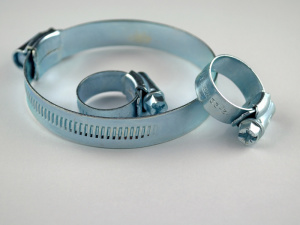 Hose clamps are an integral part of plumbing, pneumatic and automotive systems, but you might not have heard of them before unless you’ve attempted a DIY repair on your car or home. Essentially, a hose clamp or clip is a device that attaches and seals a hose onto a fitting (such as a barb or nipple). Without a properly sized hose clamp of the right quality level, a hose may leak gas, liquid or whatever substance is flowing through it. But how do you actually choose the right hose clamp? It’s easier than you think, as long as you pay attention to the three main properties of any hose clamp: type, material and size.
Hose clamps are an integral part of plumbing, pneumatic and automotive systems, but you might not have heard of them before unless you’ve attempted a DIY repair on your car or home. Essentially, a hose clamp or clip is a device that attaches and seals a hose onto a fitting (such as a barb or nipple). Without a properly sized hose clamp of the right quality level, a hose may leak gas, liquid or whatever substance is flowing through it. But how do you actually choose the right hose clamp? It’s easier than you think, as long as you pay attention to the three main properties of any hose clamp: type, material and size.
- Clamp Types
There are quite a few different designs used for hose clamps. Wire hose clamps are typically just metal bent into a U shape, while spring clamps resemble coil springs. Heavy duty clamps are actually tightened with bolts and can be reused, whereas others are single-use and more akin to zip ties. One type of clamp that is used in many different applications because of its versatility is a worm hose clamp, since these are typically both affordably priced and reusable. They can even be daisy-chained together to accommodate larger hose diameters (though you should strive to buy the right size, as is discussed below). - Clamp Materials
You can get hose clamps made out of everything from plastic and lightweight aluminum to heavy iron. In general, the strength of the clamp should correspond to the amount of pressure expected based on the hose’s diameter and flow rate. Stainless hose clamps are always a popular mid-range choice, since they’re strong, economically priced and easy to work with. - Clamp Sizes
Hose clamps come in a wide variety of sizes to meet any fastening needs, and figuring out what size to buy is relatively straightforward as long as you measure carefully. Measure the outside diameter of the hose to be clamped, with the fitting already inside, using either inches or millimeters depending on the scale of the project. Then select a hose clamp for which that outside diameter falls somewhere between the maximum and minimum listed. You definitely want to measure, rather than just going to the store and grabbing one of the large hose clamps or small hose clamps based on your memory. Clamp sizes need to be precise.
What other questions do you have about hose clamps? Do you have tips to share on buying clamps? Ask or chime in in the comments section.

